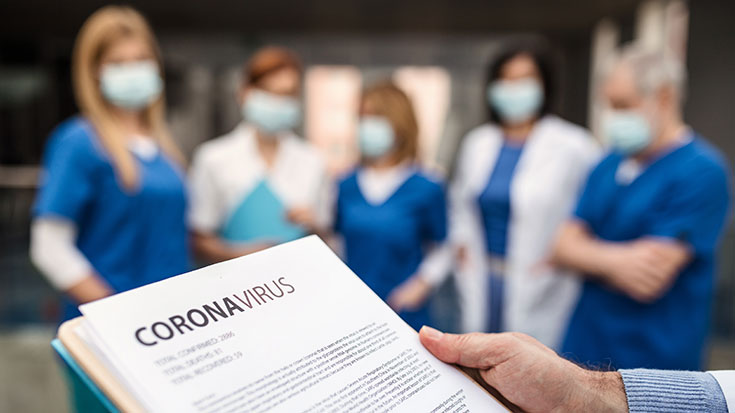
COVID-19 has taken the world by storm and it doesn’t seem to be leaving anytime soon. So, as the coming months bring winter and cool crisp weather, you as a respiratory therapist may begin to worry about your patients living with asthma. With no vaccine for COVID-19 and asthma triggering weather on the horizon, it is important to make sure your patients are extra careful this winter season.
That’s why we asked for some help from AARC member Joyce Baker, RRT, RRT-NPS, AE-C, who currently serves as the asthma clinical program coordinator for Children’s Hospital Colorado. The following is a list of frequently asked questions regarding asthma and COVID-19 compiled by Joyce. Read them over and share them with your asthma patients—
Asthma – COVID-19 FAQ
Q: Is asthma “at risk” for COVID-19?
A: People with asthma are more likely to be hospitalized than someone without asthma, mostly because viral illnesses can trigger asthma exacerbations. We cannot say whether asthma attacks from COVID-19 are any different than asthma attacks from any other viral infection. Good ways to decrease risk of an asthma attack from a viral illness is to:
- Take daily controller medications.
- Take inhaled corticosteroid medication, which MAY decrease susceptibility of infection
- Make sure asthma medications are refilled.
- Call your health care provider if the quick reliever does not resolve asthma symptoms.
Q: Should a child with asthma return to in person classrooms?
A: The American Academy of Pediatrics (AAP) released guidelines saying that it “strongly advocates” the goal of having students “physically present in school.” The AAP based their recommendations on the following emerging evidence:
- Children are much less likely than adults to get very sick from the virus. Children 10 years old and younger are also less likely to transmit the virus to others.
- No more risk than flu season.
- School closures resulted in significant ‘harms’ to children. These harms included a lack of socialization, learning deficits, a decreased ability for schools to monitor problems like depression and abuse, and less access for students to physical activity and to affordable or free food.
- If a family chooses not to have a child return to in person classroom it is important to respect this decision.
Q: Are there different precautions for a person with asthma who is returning to in person classroom or work?
A: No, people with asthma can return to an in-person classroom or work. All children two and older should wear a mask to prevent the spread, there is no exemption for asthma.
Q: What if a child with asthma has shortness of breath and wheezing requiring quick reliever therapy at school?
A: Administer the inhaler per the School Asthma Care Plan. Screen for additional, non-asthma related symptoms using the COVID-19 screening tool.
Q: Should the child with asthma be isolated from the other children and sent home after being given their quick reliever?
A: This is an evolving issue. Screen for additional, non-asthma related symptoms using the COVID-19 screening tool. If screening is negative continue to follow the Asthma Care Plan. If screening is positive follow the local school guidelines.
Q: What should be the treatment plan if a person with asthma has been exposed?
A: Treat the person with asthma the same as any other person who has been exposed. Encourage them to follow their asthma action plan If they have symptoms such as fever, runny nose, diarrhea or vomiting, sore throat encourage them to call their medical provider to be tested.
Q: Should a person with asthma participate in athletic activities or gym?
A: Yes, they should continue to be active.
Q: What is the best type of mask for a person with asthma?
A: Some covering is better than no covering. Ideally finding a mask that is comfortable to wear, goes over the ears and does not require to constantly pull up or adjust (neck gator, bandana).
Q: Indoor sports and mask use
A: Most states require masks to be worn for all indoor activities. There are nice masks made by sports companies with wicking material that may be more comfortable. Masks are recommended when physical distancing of 6 feet is not able to be maintained.
Q: There are concerns that wearing a mask for the entire day could make asthma worse?
A: The World Health Organization (WHO) also has a webpage of Myth busters and advice for the public that addresses some circulating misconceptions about the virus. Some examples included on this site include the following FACTS:
- Prolonged use of surgical/isolation masks when properly worn, DOES NOT cause carbon dioxide intoxication nor oxygen deficiency.
- People may not need to wear masks while exercising outside, particularly if they can maintain physical distancing, as masks may reduce the ability to breathe comfortably.
- If anyone with asthma is having trouble breathing at any time, including while wearing a mask, they should use their quick relief medication and call their medical provider if they do not feel better.
- To help in getting children comfortable wearing a mask and properly taking the mask/face covering on and off, the Autism Services, Education, Resources, and Training (ASERT) has a great resource for mask desensitization.
- If a parent’s preference is for their child with asthma to not wear a mask, the child should participate in online learning.
Q: What is the difference between COVID-19 and asthma symptoms?
A: People with asthma typically have symptoms of cough, shortness of breath, and wheezing. If the quick reliever does not improve symptoms or if they are experiencing other symptoms such as fever, runny nose, sore throat, diarrhea, or vomiting, encourage them to call their medical provider to be tested.
Q: How should children with asthma self-advocate
A: Know their daily control medications and what medications to take if having symptoms
It is important for children to notify their teachers and coaches that they have asthma and when they may need quick reliever medications.
Quick Links:
COVID-19 and Use of Nebulizers or Other Aerosol-Generating Procedures in a Clinic Setting
Revisiting the Need for MDI Common Canister Protocols During the COVID-19 Pandemic
AARC COVID-19 News & Resources
Email newsroom@aarc.org with questions or comments, we’d love to hear from you.














